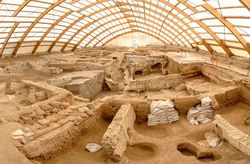Khulfa
Khulfa | |
|---|---|
 | |
| Nickname(s): Old Ziathi (Ziaŧi Khung) | |
| Population | |
| • Total | 15,000 |
| estimated | |
Khulfa (Kavahiri: /k͡xulɸa/, Adzamasi: /xʊlva/) was a city in the Kasingadh region in what is now Tabiqa. It was a large city for its region and time period, with population estimates ranging between ten to twenty thousand inhabitants, and served as the capital of the Kavahiri Kingdom and, later, the Holy Adzamic Empire. It was almost entirely destroyed in CE 923, during violent rebellions and natural disasters that marked the end of the Empire. The modern city of Ziathi is built over its remains, with some larger ruins still remaining in the city today. Since 1994, several Tabiqan universities have come together to excavate parts of the old city, funded by municipal and provincial governments and tourism.
Etymology
The meaning of the name Khulfa is unknown. /kul/ and similar segments (/khul, xol/ etc) appear in a number of toponyms throughout the Kasingadh lakes region and along the Tabiq river. The most widely-accepted theory posits that this segment originates from an undocumented language, potentially related to Kavahiri, which went extinct in prehistory.
One potential source of the name is Proto Ekuo-Lahiri *kɨwɨjlɨxʷ 'shallow slope, embankment,' which has a reflex of 'riverside, riverbank' in its Adzo-Neviric daughter family,
Some amateur linguists and archaeologists argue for the etymology 'Old lake city' based on khuŋ 'old' and ulha 'to wash' or other (usually modern) Kavahiri words. However, this has inconsistencies with records of old Kavahiri and its extinct sister languages, and furthemore, contemporary writers indicated that it was known as Khulfa throughout its existence, and therefore was likely not the 'old' city.
History
Prehistory
Kaffic period (BCE 1,000-400)
Pre-Imperial period (BCE 400-CE 6)
Early Imperial period (CE 7-340)
Adzamic occupation (341-618)
Holy Adzamic state and collapse (619-923)
Post-collapse
Rediscovery and excavation
Unlike many 'lost' ancient cities, Khulfa's unique history has ensured that it was never totally forgotten. The area lay mostly uninhabited for some five(?) hundred years after its destruction, but it was so well-preserved in the historical records of surrounding civilizations that, even largely destroyed and buried in shifting desert sands, its location remained relatively well-known. Many of its larger and more robust buildings were not completely destroyed, and became part of the urban and outlying landscape of the new city of Ziathi, some surviving to this day; materials from the ruins were often incorporated into new architecture as the settlement was rebuilt.
Ziathi, which started a few kilometers north of the site, expanded southward and over the ancient city, covering most of it by 1400.
During the 1940s Ziathi suffered some damage due to the Great Ekuosian War and Tabiqan Civil War. Several poorer areas of the city were destroyed or greatly damaged by artillery and resulting fires.